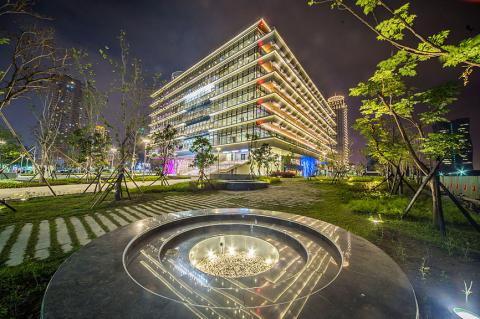The Kaohsiung Main Public Library is the world’s first column-suspended “green” building, library director Pan Cheng-yi (潘政儀) said on Saturday.
The library, which opened in Kaohsiung’s Cianjhen District (前鎮) three years ago, has become a landmark of the city with its innovative energy-saving features, Pan said.
The balconies from the third to eighth floors on the building’s west and south sides have 5m-wide lawns, while an atrium on the sixth floor features a garden with several fully grown trees.

Photo: CNA
The plants help cool the building and reduce the use of air-conditioners, given the city’s high summer temperatures, Pan said, adding that the green surroundings also help visitors refresh themselves.
“The library is a ‘green’ building that can breathe,” Pan said. “There is a garden on its roof, where visitors can view the lovely Port of Kaohsiung.”
There are more than 5,000 air vents on the library’s floors that blow cool air from the bottom up and decrease energy consumption by about 30 percent, he said, adding that the indoor plants can also lower the temperature by 2°C.
Readers, books and the environment are integrated at the library, which is not a rigid structure, but an ecological space in harmony with its surroundings, he said.
The library has set six records, including the world’s first column-suspended building and most transparent library, as well as the world’s largest suspended atrium and the first 7.5m-high square without columns, Pan said.
It is also the nation’s most systematized structure with the most flexible functions, he said.

US climber Alex Honnold is to attempt to scale Taipei 101 without a rope and harness in a live Netflix special on Jan. 24, the streaming platform announced on Wednesday. Accounting for the time difference, the two-hour broadcast of Honnold’s climb, called Skyscraper Live, is to air on Jan. 23 in the US, Netflix said in a statement. Honnold, 40, was the first person ever to free solo climb the 900m El Capitan rock formation in Yosemite National Park — a feat that was recorded and later made into the 2018 documentary film Free Solo. Netflix previewed Skyscraper Live in October, after videos

Starting on Jan. 1, YouBike riders must have insurance to use the service, and a six-month trial of NT$5 coupons under certain conditions would be implemented to balance bike shortages, a joint statement from transportation departments across Taipei, New Taipei City and Taoyuan announced yesterday. The rental bike system operator said that coupons would be offered to riders to rent bikes from full stations, for riders who take out an electric-assisted bike from a full station, and for riders who return a bike to an empty station. All riders with YouBike accounts are automatically eligible for the program, and each membership account

NUMBERS IMBALANCE: More than 4 million Taiwanese have visited China this year, while only about half a million Chinese have visited here Beijing has yet to respond to Taiwan’s requests for negotiation over matters related to the recovery of cross-strait tourism, the Tourism Administration said yesterday. Taiwan’s tourism authority issued the statement after Chinese-language daily the China Times reported yesterday that the government’s policy of banning group tours to China does not stop Taiwanese from visiting the country. As of October, more than 4.2 million had traveled to China this year, exceeding last year. Beijing estimated the number of Taiwanese tourists in China could reach 4.5 million this year. By contrast, only 500,000 Chinese tourists are expected in Taiwan, the report said. The report

Temperatures are forecast to drop steadily as a continental cold air mass moves across Taiwan, with some areas also likely to see heavy rainfall, the Central Weather Administration (CWA) said. From today through early tomorrow, a cold air mass would keep temperatures low across central and northern Taiwan, and the eastern half of Taiwan proper, with isolated brief showers forecast along Keelung’s north coast, Taipei and New Taipei City’s mountainous areas and eastern Taiwan, it said. Lows of 11°C to 15°C are forecast in central and northern Taiwan, Yilan County, and the outlying Kinmen and Lienchiang (Matsu) counties, and 14°C to 17°C